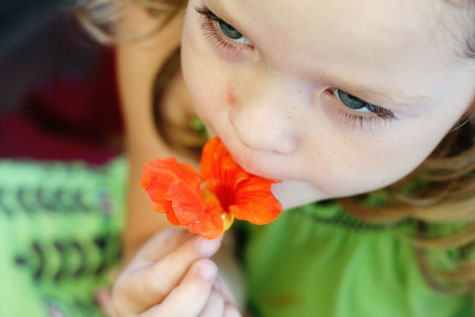Our gardens are full of flowers that are bursting with color, interesting shapes and fragrances. But, some of them may actually also be edible. See the 10 Commandments of Edible Flowers below and check the list to see if you have any edible flowers growing in your yard.
THE 10 COMMANDMENTS OF EDIBLE FLOWERS
1. Eat only those flowers you can positively identify as safe and edible. Learn the Latin or botanical names, which are universally accepted (common names may vary from region to region).
2. Do not assume that restaurants and caterers always know which flowers are edible. Just
because it is on your plate does not mean it is edible (see Rule #1).
3. Eat only those flowers that have been grown organically.
4. Do not eat flowers from florists, nurseries, garden centers or public gardens (see Rule #3).
5. Do not eat flowers if you have hay fever, asthma or allergies.
6. Do not eat flowers picked from the side of heavily trafficked roads.
7. Eat only the petals of flowers; always remove and discard the pistils and stamens before eating. (Except for the tiny flowers like thyme where it would be like performing microsurgery to remove the pistils and stamens.)
8. Not all sweet-smelling flowers are edible; some are poisonous.
9. Eat only the flowers of the recommended plants; other parts may be toxic or inedible, even though the flower may be delicious.
10. Gradually introduce flowers into your diet – one at a time and in small quantities, the way you would new food to a baby.

COMMON NAME – BOTANIC NAME – FLAVOR
Anise hyssop Agastache foeniculum – Licorice
Apple Malus spp. – Floral
Arugula Eruca vesicaria sativa- Peppery
Banana Musa spp. – Sweet
Basil Ocimum basilicum – Herbal
Bee balm Monarda didyma – Spicy/sweet
Borage Borago officinalis – Cucumber
Broccoli Brassica oleracea – Spicy
Calendula Calendula officinalis – Slightly bitter
Canary creeper Tropaeolum peregrinum – Peppery
Chamomile Anthemis nobilis – Apple
Chicory Cichorium intybus- Slightly bitter
Chives Allium schoenoprasum – Oniony
Chrysanthemum Dendranthema grandiflorum – Mild to slightly bitter
Coriander (Cilantro) Coriandrum sativum – Herbal
Dandelion Taraxacum officinale -Sweet-slightly bitter
Daylily Hemerocallis spp. – Sweet to vegetal
Dianthus Dianthus caryophyllus – Sweet, clove
Dill Anethum graveolens – Herbal
Elderberry Sambucus Canadensis – Sweet
English daisy Bellis perennis – Slightly bitter
Fennel Foeniculum vulgare – Herbal
Garlic chives Allium tuberosum- Garlicky
Hibiscus Hibiscus rosa-sinensis – Mild citrus
Hollyhock Alcea rosea – Mild nutty
Honeysuckle Lonicera japonica – Sweet floral
Hyssop Hyssopus officinalis – Strong herbal
Japanese plum Prunus ‘Mume’- Sweet almond
Jasmine Jasminum sambac & J. officinale – Sweet floral
Johnny-jump-up Viola tricolor – Slightly minty
Kale Brassica oleracea, Acephala gr. – Spicy
Lavender Lavandula spp. – Strong floral
Lemon Citrus limon- Sweet citrus
Lemon verbena Aloysia triphylla – Sweet citrus
Lilac Syringa spp. – Floral
Linden Tilia spp. – Sweet
Marjoram Origanum vulgare – Herbal
Mint Mentha spp. – Minty
Mustard Brassica juncea – Spicy
Nasturtium Tropaeolum majus – Peppery
Nodding onion Allium cernuum – Oniony
Ocotillo Fouquieria splendens – Sweet cranberry
Okra Abelmoschus aesculentus – Mild, sweet
Orange Citrus sinensis – Sweet citrus
Oregano Origanum spp. – Herbal
Pansy Viola x wittrockiana – Slight minty
Pea Pisum sativum – Pea-like
Pineapple guava Feijoa sellowiana – Sweet tropical
Pineapple sage Salvia elegans – Spicy sweet
Radish Raphanus sativus- Peppery
Red clover Trifolium pretense – Sweet
Redbud Cercis Canadensis – Pea-like
Rose Rosa spp. – Floral
Rose of Sharon Hibiscus syriacus – Mild
Roselle Hibiscus sabdariffa – Mild citrus
Rosemary Rosmarinus officinalis – Herbal
Runner bean Phaseolus coccineus – Bean-like
Safflower Carthamus tinctorius – Bitter
Sage Salvia officinalis – Herbal
Scented geranium Pelargonium spp. – Floral
Shungiku Chrysanthemum coronarium – Slightly bitter
Signet marigold Tagetes signata (T. tenuifolia) – Citrusy tarragon
Society garlic Tulbaghia violacea – Sweet garlicky
Squash Curcubita pepo spp. – Vegetal
Summer savory Satureja hortensis – Herbal
Sunflower Helianthus annuus – Bittersweet
Sweet woodruff Galium odoratum – Fresh, sweet
Thyme Thymus spp. – Herbal
Tuberous begonia Begonia x tuberhybrida- Citrus
Tulip Tulipa spp. – Bean- or pea-like
Violet Viola odorata – Sweet floral
Winter savory Satureja Montana – Herbal
Yucca Yucca spp. – Sweet (must be cooked)

Origin: Cathy Wilkinson Barash is author of numerous garden books including Edible Flowers: From Garden to Palate.

